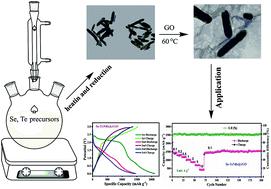当前位置:
X-MOL 学术
›
Inorg. Chem. Front.
›
论文详情
Our official English website, www.x-mol.net, welcomes your feedback! (Note: you will need to create a separate account there.)
Construction of well-designed 1D selenium–tellurium nanorods anchored on graphene sheets as a high storage capacity anode material for lithium-ion batteries
Inorganic Chemistry Frontiers ( IF 7 ) Pub Date : 2020-03-02 , DOI: 10.1039/c9qi01701a Sadeeq Ullah 1, 2, 3, 4 , Ghulam Yasin 1, 2, 3, 4 , Aftab Ahmad 2, 3, 4, 5 , Lei Qin 6, 7, 8, 9, 10 , Qipeng Yuan 1, 2, 3, 4 , Arif Ullah Khan 1, 2, 3, 4 , Usman Ali Khan 1, 2, 3, 4 , Aziz Ur Rahman 1, 2, 3, 4 , Yassine Slimani 11, 12, 13, 14
Inorganic Chemistry Frontiers ( IF 7 ) Pub Date : 2020-03-02 , DOI: 10.1039/c9qi01701a Sadeeq Ullah 1, 2, 3, 4 , Ghulam Yasin 1, 2, 3, 4 , Aftab Ahmad 2, 3, 4, 5 , Lei Qin 6, 7, 8, 9, 10 , Qipeng Yuan 1, 2, 3, 4 , Arif Ullah Khan 1, 2, 3, 4 , Usman Ali Khan 1, 2, 3, 4 , Aziz Ur Rahman 1, 2, 3, 4 , Yassine Slimani 11, 12, 13, 14
Affiliation

|
Lithium ion batteries are considered to be smart power sources for applications in a broad range of portable electronics and fast-growing electric vehicles. However, the existing electrode system suffers from a limited lifespan triggered by lithium alloying agglomeration, which affects the full-scale reversible insertion of Li+ into the anode material. The discovery of novel alternative strategies that could improve the lifespan and rate performance of active electrode materials is of immense importance. Herein, we fabricated two semiconductor metalloids, selenium and tellurium, into a 1D architecture (Se/Te nanorods) and subsequently wrapped in reduced graphene oxide (rGO) nanosheets. The designed Se/Te nanorods at GO material is named Se/Te@rGO composite and investigated as the anode material for Li+ ion batteries. The Se/Te@rGO electrode showed an exceptional reversible storage capacity of 1456 mA h g−1 as compared to SeNr (400 mA h g−1) and Se/TeNr (800 mA h g−1) at 0.1 A g−1 after 100 cycles. Furthermore, when cycled at 5 A g−1, the Se/Te@rGO electrode showed an initial specific capacity of 804 mA h g−1 and retained a high specific capacity of 704 mA h g−1 after 3000 cycles (99.5% C.E), indicating the superior performance of the newly fabricated hybrid material. The improved electrochemical storage performance of the Se/Te@rGO electrode material could be ascribed to the 1D Se/Te nanorod architecture, which can provide a short diffusion path for Li-ions and buffer the strain produced during charge–discharge cycles. The incorporated 2D rGO template further enhanced the mechanical strength of the active Se/Te material and suppressed its dissolution and volume expansion during lithiation/delithiation processes. Our contribution highlights substantial progress in the development of high storage materials for applications in long-life Li-ion batteries.
中文翻译:

精心设计的固定在石墨烯片上的一维硒-碲纳米棒的构建,作为锂离子电池的高存储容量阳极材料
锂离子电池被认为是智能电源,可广泛应用于便携式电子产品和快速增长的电动汽车中。然而,现有的电极系统受到锂合金附聚引发的有限寿命的影响,这影响了Li +到阳极材料中的可逆完全插入。发现可以提高活性电极材料的寿命和速率性能的新颖替代策略非常重要。在这里,我们将硒和碲这两种半导体准金属制成了一维结构(Se / Te纳米棒),然后包裹在还原的氧化石墨烯(rGO)纳米片中。在GO材料处设计的Se / Te纳米棒被称为Se / Te @ rGO复合材料,并被研究用作Li的阳极材料+离子电池。与100次循环后在0.1 A g -1下的SeNr(400 mA hg -1)和Se / TeNr(800 mA hg -1)相比,Se / Te @ rGO电极显示出1456 mA hg -1的出色可逆存储容量。此外,当在5 A g -1下循环时,Se / Te @ rGO电极显示出初始比容量为804 mA hg -1,并保持了704 mA hg -1的高比容量。经过3000次循环(99.5%CE),表明新制造的混合材料具有卓越的性能。Se / Te @ rGO电极材料电化学存储性能的提高归因于一维Se / Te纳米棒结构,该结构可为锂离子提供短扩散路径并缓冲充放电循环中产生的应变。内置的二维rGO模板进一步增强了活性Se / Te材料的机械强度,并抑制了其在锂化/脱锂过程中的溶解和体积膨胀。我们的贡献突显了用于长寿命锂离子电池的高存储材料开发的重大进展。
更新日期:2020-04-24
中文翻译:

精心设计的固定在石墨烯片上的一维硒-碲纳米棒的构建,作为锂离子电池的高存储容量阳极材料
锂离子电池被认为是智能电源,可广泛应用于便携式电子产品和快速增长的电动汽车中。然而,现有的电极系统受到锂合金附聚引发的有限寿命的影响,这影响了Li +到阳极材料中的可逆完全插入。发现可以提高活性电极材料的寿命和速率性能的新颖替代策略非常重要。在这里,我们将硒和碲这两种半导体准金属制成了一维结构(Se / Te纳米棒),然后包裹在还原的氧化石墨烯(rGO)纳米片中。在GO材料处设计的Se / Te纳米棒被称为Se / Te @ rGO复合材料,并被研究用作Li的阳极材料+离子电池。与100次循环后在0.1 A g -1下的SeNr(400 mA hg -1)和Se / TeNr(800 mA hg -1)相比,Se / Te @ rGO电极显示出1456 mA hg -1的出色可逆存储容量。此外,当在5 A g -1下循环时,Se / Te @ rGO电极显示出初始比容量为804 mA hg -1,并保持了704 mA hg -1的高比容量。经过3000次循环(99.5%CE),表明新制造的混合材料具有卓越的性能。Se / Te @ rGO电极材料电化学存储性能的提高归因于一维Se / Te纳米棒结构,该结构可为锂离子提供短扩散路径并缓冲充放电循环中产生的应变。内置的二维rGO模板进一步增强了活性Se / Te材料的机械强度,并抑制了其在锂化/脱锂过程中的溶解和体积膨胀。我们的贡献突显了用于长寿命锂离子电池的高存储材料开发的重大进展。


























 京公网安备 11010802027423号
京公网安备 11010802027423号